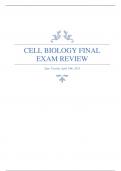Summary
Summary Comprehensive exam review: EVERYTHING you need to know from student who got 98 in Cell Bio 2382
- Course
- Bio 2382
- Institution
- University Of Western Ontario (UWO )
Comprehensive final exam review: EVERYTHING you need to know from student who got 98% in Cell Bio 2382
[Show more]



